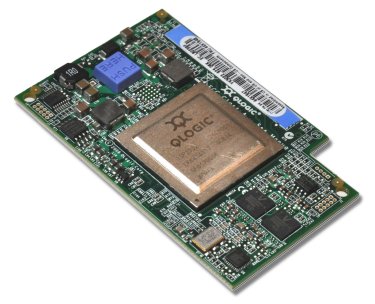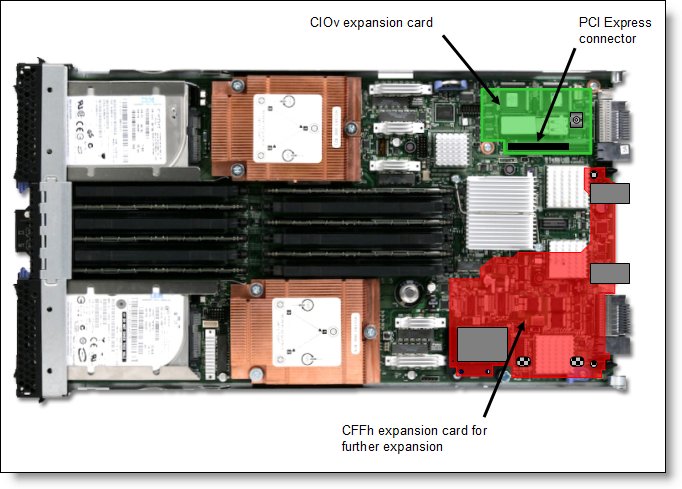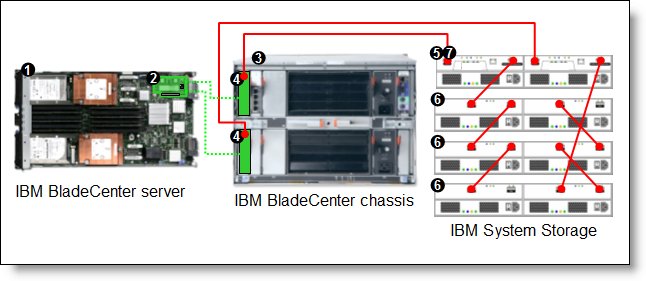Abstract
The QLogic 8Gb Fibre Channel Expansion Card (CIOv) for BladeCenter enables high-speed access for IBM blade servers to connect to a Fibre Channel storage area network (SAN). When compared to the previous-generation 4 Gb adapters, the new adapter doubles the throughput speeds for Fibre Channel traffic. As a result, you can manage increased amounts of data and possibly benefit from a reduced hardware expense. For example, in bandwidth constrained Microsoft Exchange environments, by using 8 Gb adapters and switches, you can deploy 68% less adapter and switch hardware to support the same number of users as 4 Gb adapters.
Note: The adpater is withdrawn from marketing.
Introduction
The QLogic 8Gb Fibre Channel Expansion Card (CIOv) for BladeCenter enables high-speed access for blade servers to connect to a Fibre Channel storage area network (SAN). When compared to the previous-generation 4 Gb adapters, the new adapter doubles the throughput speeds for Fibre Channel traffic. As a result, you can manage increased amounts of data and possibly benefit from a reduced hardware expense. For example, in bandwidth constrained Microsoft Exchange environments, by using 8 Gb adapters and switches, you can deploy 68% less adapter and switch hardware to support the same number of users as 4 Gb adapters.
Figure 1 shows the QLogic 8Gb Fibre Channel Expansion Card (CIOv).

Figure 1. QLogic 8Gb Fibre Channel Expansion Card (CIOv)
Did you know?
The performance bottleneck with Fibre Channel storage typically exists in the switching. By moving to 8 Gb adapters and switches, you can optimize the bottleneck to the storage controller, where it can be managed by expanding the disks attached to storage.
The adapter connects to the midplane directly, without having to use cables or small form-factor pluggable (SFP) modules. By eliminating these components for up to 14 servers, the resulting savings alone covers the investment in the BladeCenter chassis.
Part number information
Table 1 shows the part number to order this card.
Table 1. Part number and feature code for ordering
| Description | Part number | Feature code** |
| QLogic 8Gb Fibre Channel Expansion Card (CIOv) for BladeCenter | 44X1945* | 1462 / 8242 |
* Withdrawn from marketing
** The first feature code listed is for configurations available through the System x sales channel. The second feature code listed is for configurations available through the Power Systems sales channel
The part number includes the following items:
- One QLogic 8Gb Fibre Channel Expansion Card (CIOv) for BladeCenter
- Documentation package
Features
The QLogic 8Gb Fibre Channel Expansion Card (CIOv) has the following features:
- CIOv form factor
- QLogic 2532 8Gb ASIC
- PCI Express 2.0 host interface
- Support for two full-duplex Fibre Channel ports at 8 Gbps maximum per channel
- Support for Fibre Channel Protocol Small Computer System Interface (FCP-SCSI) and Fibre Channel Internet Protocol (FC-IP)
- Support for Fibre Channel service (class 3)
- Support for switched fabric, point-to-point, and Fibre Channel Arbitrated Loop (FC-AL) connections
- Support for NPIV when installed in the JS23/JS43
- Configuration and boot support in BIOS and UEFI
Operating environment
The expansion card is supported in the following environment:
- Temperature: 10°C to 35°C (50°F to 95°F)
- Relative humidity: 8% to 80% non-condensing
Supported servers and I/O modules
This card is installed in the PCI Express CIOv slot of a supported blade server. It provides connections to Fibre Channel-compatible modules in bays 3 and 4 of the supported BladeCenter chassis. A maximum of one CIOv is supported per single-wide (30 mm) blade server. Table 2 lists the BladeCenter servers that support the QLogic 8Gb Fibre Channel Expansion Card (CIOv).
Table 2. Supported servers
| QLogic 8Gb Fibre Channel Expansion Card (CIOv) | 44X1945 | N | N | N | Y | Y | Y | N | N | N | N | N | N | N | Y | Y |
See IBM ServerProven at the following Web address for the latest information about the expansion cards that are supported by each blade server type:
http://ibm.com/servers/eserver/serverproven/compat/us/
CIOv expansion cards are installed in the CIOv slot in supported servers, such as the HS22, as highlighted in green in Figure 2.

Figure 2. Location of the CIOv slot in the BladeCenter HS22
The QLogic 8Gb Fibre Channel Expansion Card (CIOv) requires that a supported I/O module is installed in bay 3 and bay 4 of the chassis in which the cards and servers are installed.
Table 3 lists the supported I/O modules that can be used to connect to the expansion card. The 8 Gb switch modules are recommended. The card also supports 4 Gb Fibre Channel switch modules and the 4 Gb Intelligent Pass-thru Module. However, the card must operate at the 4 Gbps rate.
Table 3. I/O modules recommended for use with the QLogic 8Gb Fibre Channel Expansion Card (CIOv)
| Supported I/O modules (operate at 8 Gbps) | ||||||
| QLogic 20-Port 8 Gb SAN Switch Module | 44X1905 | Y | Y | Y | Y* | Y† |
| QLogic 8 Gb Intelligent Pass-thru Module | 44X1907 | Y | Y | Y | Y* | Y† |
| Brocade Enterprise 20-port 8Gb SAN Switch Module for BladeCenter | 42C1828 | N | Y | Y | N | Y† |
| Brocade 20-port 8Gb SAN Switch Module for BladeCenter | 44X1920 | N | Y | Y | N | Y† |
| Brocade 10-port 8Gb SAN Switch Module for BladeCenter | 44X1921 | N | Y | Y | N | Y† |
| Supported I/O modules (operate at 4 Gbps) | ||||||
| Brocade 4 Gb 20-Port SAN Switch Module | 32R1812 | N | N | N | N | N |
| Brocade 4 Gb 10-Port SAN Switch Module | 32R1813 | N | N | N | N | N |
| Cisco 4 Gb 20-Port Fibre Channel Switch Module | 39Y9280 | N | Y | Y | Y* | Y |
| Cisco 4 Gb 10-Port Fibre Channel Switch Module | 39Y9284 | Y | Y | Y | Y* | Y |
| QLogic 4 Gb 20-Port Fibre Channel Switch Module | 26R0881 | N | Y | Y | Y* | Y |
| QLogic 4 Gb 10-Port Fibre Channel Switch Module | 32R1904 | N | Y | Y | Y* | Y |
| QLogic 20-Port 4 Gb SAN Switch Module | 43W6725 | N | Y | Y | Y* | Y |
| QLogic 10-Port 4 Gb SAN Switch Module | 43W6724 | Y | Y | Y | Y* | Y |
| QLogic 4 Gb Intelligent Pass-thru Module | 43W6723 | Y | Y | Y | Y* | Y |
| McDATA 4 Gb 20-Port Fibre Channel Switch Module | 32R1833 | N | Y | Y | Y* | Y |
| McDATA 4 Gb 10-Port Fibre Channel Switch Module | 32R1905 | N | Y | Y | Y* | Y |
| QLogic 4 Gb Intelligent Pass-thru Module | 43W6723 | Y | Y | Y | Y* | Y |
Consider the following restrictions regarding the use of the switch modules in Table 3:
- The BladeCenter Optical Pass-thru Module, 39Y9316, is not supported
- (*) When any of the switch modules that have an asterisk (*) is installed in BladeCenter T, the internal switch connections to blade ports operate at 2 Gbps. The external ports operate at up to 8 Gbps (or 4 Gbps for 4 Gb switch modules).
- (†) When any of these switch modules that have the dagger indicator symbol (†) is installed in BladeCenter HT, the internal switch connections to blade ports are supported at 4 Gbps. The external ports operate at up to 8 Gbps (or 4 Gbps for 4 Gb switch modules).
- The QLogic 8Gb Fibre Channel Expansion Card (CIOv) can be installed in servers in the BladeCenter S and used with supported switch modules as shown in the table. However, by doing so, you lose the ability to connect to the BladeCenter S Disk Storage Modules (DSMs). The Fibre Channel expansion card goes in the place of the SAS expansion card that is needed to connect to the DSMs.
Popular configurations
The QLogic 8Gb Fibre Channel Expansion Card (CIOv) can be used in various configurations. Figure 3 shows the CIOv card installed in a supported blade server, which in turn is installed in a BladeCenter chassis. The chassis is connected to the IBM System Storage DS3400. The RAID functionality is provided by the external storage system.

Figure 3. BladeCenter connected to an external IBM System Storage DS3400 storage solution
Table 4 lists the parts that are used in the configuration shown in Figure 3.
Table 4. Components used when connecting the QLogic 8Gb Fibre Channel Expansion Card (CIOv) to external disk storage (as shown in Figure 3)
| Diagram reference | Part number / Machine type | Description | Quantity |
| 7870 | BladeCenter HS22 or other supported server | 1 to 14 | |
| 44X1945 | QLogic 8Gb Fibre Channel Expansion Card (CIOv) | 1 per server | |
| Varies | BladeCenter chassis* (see Table 3) | 1 | |
| 44X1905 | QLogic 20-Port 8 Gb SAN Switch Module | 1 or 2 | |
| 1726-41X or 1726-42X | IBM System Storage DS3400 (Single or Dual Controller) | 1 | |
| 1727 | Optional: IBM System Storage EXP3000 (Single or Dual ESM) | 1 to 3 | |
| 39R6536 | DS3000 Partition Expansion License | 1 |
*Note: The expansion card can be installed in servers in the BladeCenter S (8886). However, by doing so, you lose the ability to connect to the BladeCenter S DSMs. The Fibre Channel expansion card goes in the place of the SAS expansion card that is needed to connect to the DSMs.
This configuration also requires cabling between the chassis and the storage server and between the storage server and expansion units. The cable part numbers are not listed in Table 4. Note that the DS3400 storage solution operates at 4 Gbps.
Supported operating systems
The QLogic 8Gb Fibre Channel Expansion Card (CIOv) supports the following operating systems:
- IBM AIX 5L for POWER Version 5.3
- IBM AIX Version 6.1
- IBM Virtual I/O Server
- IBM i operating system 6.1
- Microsoft Windows Essential Business Server 2008 Premium Edition
- Microsoft Windows Essential Business Server 2008 Standard Edition
- Microsoft Windows Server 2003, Web Edition
- Microsoft Windows Server 2003/2003 R2, Enterprise Edition
- Microsoft Windows Server 2003/2003 R2, Enterprise x64 Edition
- Microsoft Windows Server 2003/2003 R2, Standard Edition
- Microsoft Windows Server 2003/2003 R2, Standard x64 Edition
- Microsoft Windows Server 2008 R2
- Microsoft Windows Server 2008, Datacenter x64 Edition
- Microsoft Windows Server 2008, Datacenter x86 Edition
- Microsoft Windows Server 2008, Enterprise x64 Edition
- Microsoft Windows Server 2008, Enterprise x86 Edition
- Microsoft Windows Server 2008, Standard x64 Edition
- Microsoft Windows Server 2008, Standard x86 Edition
- Microsoft Windows Server 2008, Web x64 Edition
- Microsoft Windows Server 2008, Web x86 Edition
- Microsoft Windows Small Business Server 2003/2003 R2 Premium Edition
- Microsoft Windows Small Business Server 2003/2003 R2 Standard Edition
- Microsoft Windows Small Business Server 2008 Premium Edition
- Microsoft Windows Small Business Server 2008 Standard Edition
- Red Hat Enterprise Linux 4 AS for AMD64/EM64T
- Red Hat Enterprise Linux 4 AS for x86
- Red Hat Enterprise Linux 4 ES for AMD64/EM64T
- Red Hat Enterprise Linux 4 ES for x86
- Red Hat Enterprise Linux 4 WS/HPC for AMD64/EM64T
- Red Hat Enterprise Linux 4 WS/HPC for x86
- Red Hat Enterprise Linux 4 for IBM POWER
- Red Hat Enterprise Linux 5 Server Edition
- Red Hat Enterprise Linux 5 Server Edition with Xen
- Red Hat Enterprise Linux 5 Server with Xen x64 Edition
- Red Hat Enterprise Linux 5 Server x64 Edition
- Red Hat Enterprise Linux 5 for IBM POWER
- SUSE LINUX Enterprise Server 10 for AMD64/EM64T
- SUSE LINUX Enterprise Server 10 for IBM POWER
- SUSE LINUX Enterprise Server 10 for x86
- SUSE LINUX Enterprise Server 10 with Xen for AMD64/EM64T
- SUSE LINUX Enterprise Server 10 with Xen for x86
- SUSE LINUX Enterprise Server 11 for AMD64/EM64T
- SUSE LINUX Enterprise Server 11 for IBM POWER
- SUSE LINUX Enterprise Server 11 with Xen for AMD64/EM64T
- VMware ESX 3.5
- VMware ESX 4.0
- VMware ESXi 3.5
- VMware ESXi 4.0
See IBM ServerProven at the following address for the latest information about the specific versions and service packs that are supported:
http://ibm.com/servers/eserver/serverproven/compat/us/
Select the blade server and then select the expansion card to see the supported operating systems.
Related product families
Product families related to this document are the following:
Trademarks
Lenovo and the Lenovo logo are trademarks or registered trademarks of Lenovo in the United States, other countries, or both. A current list of Lenovo trademarks is available on the Web at https://www.lenovo.com/us/en/legal/copytrade/.
The following terms are trademarks of Lenovo in the United States, other countries, or both:
Lenovo®
BladeCenter®
ServerProven®
System x®
The following terms are trademarks of other companies:
Linux® is the trademark of Linus Torvalds in the U.S. and other countries.
Microsoft®, Windows Server®, and Windows® are trademarks of Microsoft Corporation in the United States, other countries, or both.
IBM®, AIX®, and ibm.com® are trademarks of IBM in the United States, other countries, or both.
Other company, product, or service names may be trademarks or service marks of others.
